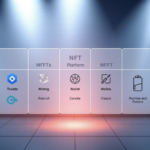Now Reading: Avalanche vs Solana: Which Blockchain is Better for You?
- 01
Avalanche vs Solana: Which Blockchain is Better for You?
Avalanche vs Solana: Which Blockchain is Better for You?
The blockchain space has seen fierce competition among platforms aiming to solve scalability and speed challenges. Two notable contenders emerged in 2020 with distinct visions: one prioritizing customizable networks, and the other emphasizing raw transaction throughput. This comparison explores their core philosophies to help you identify the better fit for your goals.

Developers and investors often face tough choices in the rapidly evolving cryptocurrency ecosystem. While both platforms share a focus on efficiency, their technical architectures diverge sharply. One uses a unique multi-chain framework to balance flexibility and security, whereas the other achieves blazing speeds through innovative consensus mechanisms.
Understanding these differences matters for long-term strategy. Whether you’re building decentralized apps or diversifying crypto investments, each blockchain offers specific advantages. We’ll break down their transaction capabilities, ecosystem growth, and real-world use cases to simplify your decision-making process.
Key Takeaways
- Both platforms launched in 2020 with solutions for blockchain scalability issues
- Architectural differences lead to contrasting strengths in flexibility vs speed
- Transaction finality times and costs vary significantly between networks
- Developer communities prioritize different types of decentralized applications
- Investment potential depends on specific use case adoption and market trends
Introduction: The Rise of Avalanche and Solana
Blockchain’s scalability challenges sparked parallel innovations in 2020. A Cornell University professor and a Qualcomm engineer independently tackled the same problem through radically different lenses. Their solutions would reshape how networks handle transactions and build trust.
Emin Gün Sirer brought academic rigor to his platform’s design. His multi-chain approach aimed to let developers create specialized networks while maintaining security. This vision addressed growing demands for customizable solutions in decentralized finance.
Anatoly Yakovenko’s engineering background led to a breakthrough in parallel processing. His system enabled simultaneous transaction validation through unique timestamping. This innovation positioned his network as a leader in speed, particularly for staking rewards and high-frequency trading.
Both projects launched as the crypto market demanded better infrastructure. Existing platforms struggled with congestion and fees during the 2020 DeFi boom. These new architectures offered fresh answers to the blockchain trilemma – balancing speed, security, and decentralization.
The founders’ contrasting expertise created distinct philosophies. One prioritized flexible subnetworks, while the other optimized raw throughput. These choices continue influencing their ecosystems’ growth trajectories today.
Exploring Avalanche: Innovation and Multi-Chain Flexibility
Modern blockchain solutions demand both speed and adaptability. One platform answers this through a unique three-part architecture that separates core functions while enabling custom networks. This design empowers developers to balance specialization with interoperability.

The Snowman Consensus Protocol
The system’s backbone uses repeated random sampling among validators to confirm transactions. Unlike traditional methods, this consensus protocol achieves finality in under 3 seconds while maintaining energy efficiency. Validators repeatedly query small random subsets until network agreement emerges organically.
Customized Subnet Architecture
Developers can launch specialized blockchains called subnets with tailored rules. Each subnet operates independently while benefiting from the main network’s security. Key components include:
- X-Chain: Handles asset transfers using AVAX tokens
- C-Chain: Executes Ethereum-compatible smart contracts
- P-Chain: Coordinates validators and subnet creation
This structure allows enterprises to build industry-specific networks without compromising speed. Subnets can implement unique consensus protocols while interacting with other chains through standardized bridges. The AVAX token fuels transactions across all three chains, creating a unified economic model.
Unpacking Solana: High-Performance Blockchain Design
Decentralized systems require breakthroughs to achieve enterprise-grade performance. One network redefines speed through a hybrid approach combining cryptographic innovation with optimized validation processes.
Proof of History (PoH) and Proof of Stake (PoS)
The platform’s secret weapon is its Proof of History mechanism – a cryptographic clock that timestamps transactions before consensus. This creates an ordered sequence of events, slashing communication delays between validators. Paired with Proof of Stake, the system achieves both speed and security through:
- Validator staking to prevent malicious activity
- Parallel processing of verified transaction batches
- Energy-efficient confirmation cycles
Scalability and Transaction Speed
Real-world performance metrics showcase the network’s capabilities. While theoretical limits reach 50,000 transactions per second, current averages hover around 1,200 TPS – still outpacing most rivals. Key architectural elements enabling this scalability include:
- GPU-accelerated transaction processing
- Distributed validator networks
- Optimized data compression techniques
This design comes with trade-offs. High throughput demands premium hardware for validators, potentially affecting decentralization. However, for applications needing instant settlement – like NFT marketplaces or algorithmic trading – the speed advantages often outweigh these considerations.
Avalanche vs Solana: Technical Comparison
Technical specifications often determine which blockchain gains traction for specific applications. Let’s examine critical metrics that shape developer preferences and user experiences across these networks.

Network Security and Decentralization
One platform employs a triple-layer consensus mechanism combining multiple protocols. This approach achieves 2-second transaction finality while maintaining robust security through randomized validator sampling. The system’s design allows 1,300+ validators to participate with minimal hardware requirements.
Its competitor uses a hybrid model blending timestamp verification with stake-based validation. While achieving faster throughput, this method requires high-performance servers, creating higher network participation barriers. Recent upgrades have reduced downtime incidents by 40% year-over-year.
Transaction Fees and Cost Efficiency
Microtransactions favor the chain with $0.001 per transfer fees – ideal for gaming apps requiring frequent small payments. However, the $0.01 fee alternative provides predictable pricing for complex smart contracts, as shown in this detailed comparison of these blockchain platforms.
Three key differences impact cost structures:
- Fee models: Dynamic vs fixed pricing mechanisms
- Governance: On-chain voting vs community forums
- Resource allocation: Parallel processing vs subnet isolation
Developers prioritizing transaction fees predictability often choose one network, while those needing ultra-low costs opt for the other. Both solutions demonstrate viable approaches to balancing speed and affordability in blockchain operations.
Smart Contracts and Developer Ecosystems
Programming languages shape blockchain innovation through their technical capabilities and developer accessibility. Two distinct approaches emerge in this arena – one prioritizing widespread adoption through compatibility, the other pushing performance boundaries with advanced tools.
EVM Compatibility Advantages
The Ethereum Virtual Machine standard remains a smart contract powerhouse. Developers can deploy Solidity-based applications with minimal code adjustments, accelerating project launches. This interoperability attracts teams building:
- DeFi protocols needing liquidity bridges
- NFT marketplaces requiring cross-chain functionality
- Enterprise solutions leveraging existing Ethereum tools
Rust Programming Precision
Parallel processing demands robust memory management. The network using Rust achieves this through compile-time checks preventing data races. While requiring deeper technical expertise, this approach enables:
- High-frequency trading platforms
- Real-time gaming ecosystems
- Data-intensive decentralized applications
Developer communities reflect these technical choices. Over 75% of new smart contracts on the EVM-compatible chain originate from Ethereum veterans. Meanwhile, Rust-focused platforms attract engineers optimizing for scalability in computationally heavy use cases.
Practical Applications: Trading, DeFi, and Gaming Insights

Real-world blockchain adoption thrives when technical capabilities meet user needs. The speed-focused network excels in environments requiring split-second decisions. Its sub-second finality and $0.0025 average fees power:
- Algorithmic trading platforms executing 100+ orders per minute
- NFT-based games with real-time item exchanges
- Decentralized exchanges settling swaps in under 400ms
Gaming ecosystems leverage these strengths through seamless in-app purchases and verifiable asset ownership. Play-to-earn models flourish where transaction costs stay below gameplay rewards. Over 60% of Web3 game developers now build on this network for frictionless user onboarding.
The customizable platform attracts enterprises needing specialized solutions. Financial institutions deploy private subnets for:
- Custom compliance frameworks
- Cross-border payment networks
- Tokenized asset marketplaces
DeFi innovations thrive through Ethereum compatibility, enabling complex dapps like multi-chain yield aggregators. Users benefit from predictable $0.10 smart contract fees when managing advanced financial instruments. Both networks demonstrate unique value propositions – one optimized for mass-market applications, the other for tailored blockchain solutions.
Market Dynamics: Price, Volume, and Investor Sentiment
Blockchain valuations reflect complex interactions between technical merit and market psychology. As of January 2025, one platform’s $92.8 billion valuation towers over another’s $15.4 billion cap – a gap reflecting differing adoption trajectories.
Comparing Market Caps and Trading Volumes
The larger network’s daily $3.67 billion turnover suggests stronger liquidity, crucial for institutional traders. Its $191.75 price per token contrasts with the competitor’s $36.54 valuation, influenced by supply differences.
Three factors explain the disparity:
- Ecosystem maturity: Established DeFi projects attract more capital
- Token distribution: Circulating supply impacts price stability
- Network effects: Developer activity drives long-term growth
Despite lower market cap, the smaller platform shows 88% bullish sentiment versus 85% for its rival. This optimism stems from upcoming protocol upgrades and niche adoption in enterprise solutions.
Trading patterns reveal distinct investor strategies. The high-volume chain attracts day traders seeking volatility, while the other appeals to long-term holders betting on specialized use cases. Both coins maintain strong positions in the evolving crypto landscape.
Transaction Performance Metrics: TPS and Latency Analysis
Transaction speed defines user experience in blockchain networks. One platform achieves theoretical peaks of 50,000 operations per second through parallel processing, while the other handles 4,500 transactions using multi-chain coordination. These numbers reveal contrasting approaches to scaling solutions.
Real-world performance depends on network stability and validation methods. The high-throughput chain minimizes latency to 400 milliseconds, ideal for time-sensitive applications like payment systems. Its competitor balances speed with decentralization through 2-second finality across subnets.
Developers face trade-offs when prioritizing transactions per second. While raw throughput attracts high-frequency trading platforms, predictable confirmation times matter more for enterprise use cases. Both networks demonstrate viable paths for reducing settlement durations below traditional finance standards.
Energy efficiency remains crucial as adoption grows. The faster chain requires specialized hardware to maintain speeds, potentially limiting validator diversity. The alternative’s lightweight consensus mechanism supports broader participation without sacrificing transaction reliability.
FAQ
How do transaction speeds differ between these blockchains?
One platform leverages a unique timestamp system combined with proof of stake to achieve over 2,000 transactions per second (TPS). The other uses a multi-layered consensus approach, reaching up to 4,500 TPS. Both prioritize low latency but employ distinct methods to balance speed and decentralization.
Which network provides more cost-effective transactions?
Fees vary based on network demand. While one chain often maintains sub-cent costs due to its high throughput design, the other occasionally experiences spikes during congestion. Developers typically favor the former for microtransactions, while the latter attracts institutional-grade applications.
How do their security models compare?
Security approaches diverge significantly. Proof of History paired with delegated proof of stake secures one ecosystem through verifiable time sequences. The other relies on a metastable consensus protocol involving repeated random subsampling, enhancing resistance to collusion attacks without compromising finality.
Which ecosystem better supports decentralized app development?
EVM compatibility gives one platform an edge for Ethereum developers seeking faster alternatives. The other’s Rust-based environment appeals to programmers prioritizing raw performance. Cross-chain tools and wallet integrations differ, influencing framework choices for NFT markets or prediction platforms.
What advantages do these chains offer DeFi projects?
Subnet architecture allows customized rule sets for lending protocols on one network, while the other’s single global state simplifies arbitrage bots. Stablecoin adoption rates and oracle integration depth also affect protocol deployment decisions between the two.
How do market trends impact long-term viability?
Trading volume patterns reveal differing investor priorities. One token’s price often correlates with NFT platform growth, while the other tracks infrastructure partnerships. Both face competition from emerging layer-1 solutions but maintain strong positions in derivatives trading and institutional custody services.
Which factors determine the best choice for enterprise solutions?
Enterprises evaluate privacy features, regulatory compliance tools, and node operation costs. Private subnet capabilities attract healthcare data projects on one chain, while the other’s low-latency settlement appeals to quantitative trading firms. Hybrid models using both networks are becoming common for diversified Web3 strategies.














